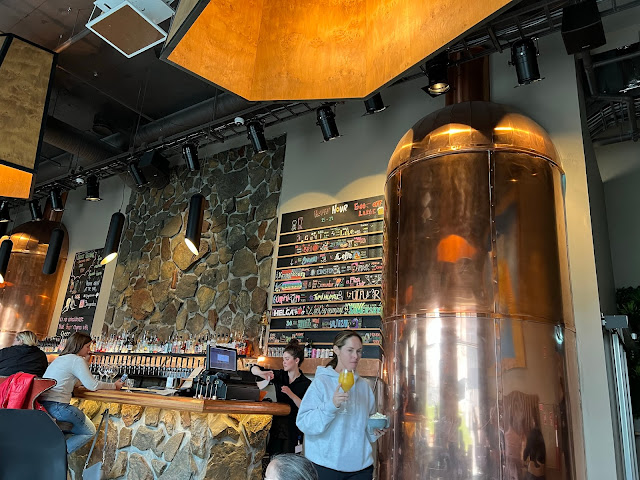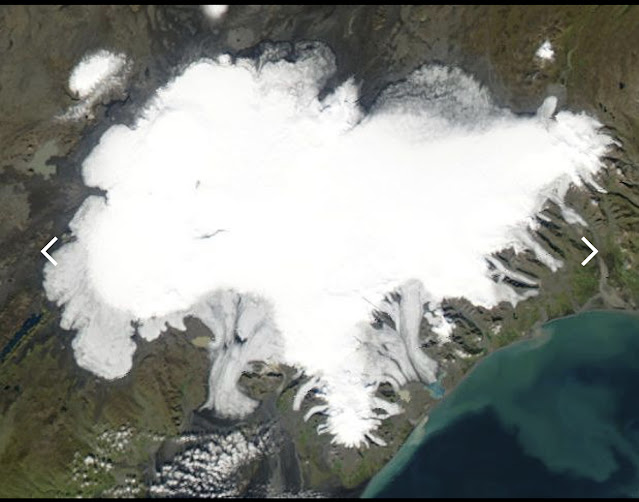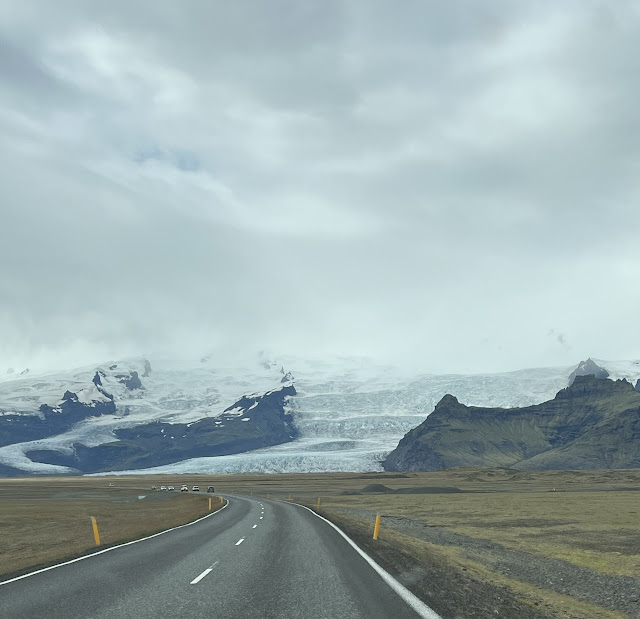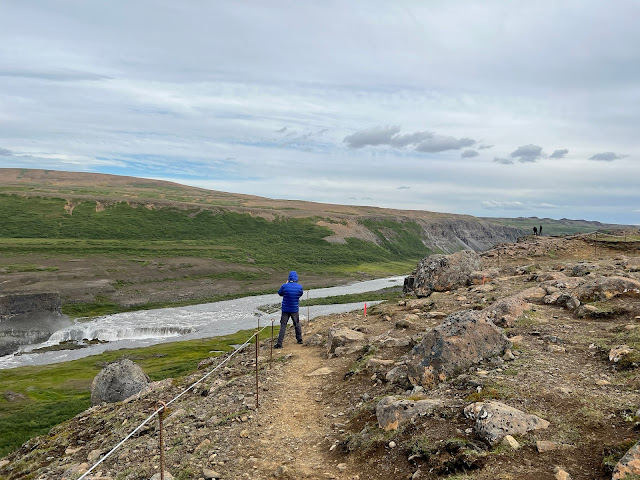[Hooray! this morning we both tested Covid negative which made us a little silly with relief but still there was a faint shadow of concern lingering about what might happen over the next couple of days however .... ]
Loath to join the flow of tourist traffic along Hwy 1, the famous ‘Ring Road’, I found an alternative route through ‘farming’ country and lava flows, passed odd mounds which looked a little like pseudocraters. Before I go on I should explain pseudocraters because they are found in very few places worldwide - Iceland, Hawaii, one in the Azore islands (which formed along the same Mid Atlantic Ridge as Iceland) - and in the Athabasca Valles region of the planet Mars apparently. These rootless/ventless craters form when hot thin molten lava flows over a wetland or boggy areas. The hot lava boils the water of the wetlands and the steam pressure causes explosions, creating clusters of these pseudocraters. We saw some near Myvatn. Now back to the road ....
 |
| In the distance is Myrdalsjokull ice cap |
 |
| Glacial melt waters meander across this relatively flat area |
 |
| Lava fields all around us |
It was quite delightful with no cars to worry about so we were able to drive as slowly and turn around as much as we chose - and unsurprisingly for us we did that many times! All the while we were heading closer to Mýrdalsjökull in the south of the Icelandic highlands. It is the country's fourth largest ice cap.
 |
| We ventured into that cave and found old whale bones |
Along our westward route, a couple of coastal features attracted me. The first, a huge block/headland of green velvet-covered rock had us picking our way along a rough rutted road towards a wide expanse of black sand. Intriguing. Conscious of the time, however - and not to mention the ground was soft and promised bogs - we kept moving west until we reach the second location that interested me. A cluster of islands off a rocky headland, Reynisfjara - a protected area for birds. Being a holiday weekend, the area was teaming with people however ....
 |
| Iceland has very few public toilets. These at Reynisfjara were 'Loos with a view' - $2 entry! |
 |
Stunning dark rocky shoreline clothed in green velvet
and hemmed in fine obsidian sand |
 |
These columns were created by the cooling of lava comprising mostly basalt
|
There are two startling focal points at Reynisfjara - one on either side of a large estuary. To the east are tall black phalanxes of ancient lava jutting ominously out of the sea and along the cliff face towering basalt columns rise into the sky; these were festooned with the adorable Atlantic puffins. In Icelandic legend, it was said that the Reynisdrangar (those 'sea stacks') are the remains of a battle between two local trolls and a three-masted ship. When daylight broke, the two trolls were turned to stone, and the ship was trapped with them for all eternity, forming a group of sea stacks which are now call the Reynisdrangar Columns. I love Icelandic sagas! One which relates to the cave inside the towering basalt columns is the Seal Skin Sage; I hope you can read the saga in the photo. Briefly it is based on the belief that seals descended from humans and that once a year they will come on land and cast off their seal skin to dance and sing through the night.

On the west side of the lagoon was a high jutting headland overlooking Dyrholaey which literally means 'the hill island with the door hole'; it is thought to have formed 80,000 years ago in a submarine eruption. The islands are protected as bird sanctuaries. There were also other strange coastal rock formations, reminiscent of Victoria’s Twelve Apostles, rising out of wide stretches of fine black sand. It's quite stunning.
Reynisfjara's long beach of black sand is supposedly the most famous beach on the South Coast of Iceland. The sand is black because it was formed from heavily eroded volcanic rocks which were black (or obsidian) having been formed from cooled lava which turns black as it cools and hardens. The area is quite fascinating but the waters are treacherous and dotted with shipwrecks so rescue winches have been built atop these high cliffs. They have unpredictable waves they call sneaker waves which have drowned a few people; there were many warning signs along the beach.
 |
| Sneaker waves - I know what they mean. R: traffic signs are cute. Smiley face and hearts if you're doing the right speed. |
Then it was back on the road; this time we had to join the weekend traffic on the 'Ring Road'. The scenery nevertheless was picture postcard perfect and I happily snapped away as we whizzed by, one of the 'motorcade'. I've included a few pix just for the sheer delight of sharing this beautiful island state: there are very few places you can pull off the road to take photos, or the like, so quality may be lacking.


 |
| Eyjafjallajokull and Myrdalsjokull on the horizon in front of us. |
 |
| Here we are approaching Skógafoss (foss is Icelandic for waterfall) |
On this trip we have seen more waterfalls than ever before in the end however we had to ration ourselves if we were to ever get back to Reykjavik. We decided to visit Skógafoss, on the Skógá river. One of Iceland's largest. Skogafoss is unique because the waterfall comes directly from two glaciers, Eyjafjallajokull and Myrdalsjokull. It was wet, we were wet! Mist from the waterfall and rain and yet it was awash with visitors. We opted against joining lots of other people who were climbing the staircase beside the falls for views over Iceland's South Coast (we were wet enough and lacked the energy). It was quite a stunner.
 |
| That's as close as we got to Skogafoss |
According to legend, the first Viking settler in the area, Thrasi Thorolfsson, buried a treasure in a cave behind the waterfall. The legend continues that locals found the chest years later, but were only able to grasp the ring on the side of the chest before it disappeared again. I can imagine Golum's chilly hand stretching out of the darkness; in fact Iceland is very much Hobbit-like.
 |
| A day of driving past glaciers, waterfalls and lava fields |
The road west into Reykjavik was almost bumper to bumper but we arrived mid afternoon and managed to find our way to our hotel - eventually. With a sense of relief we unpacked what we needed and relaxed ..... until the hotel gave an all mighty shudder! I rushed downstairs to reception to ask what was going on, whether that was an earthquake. "Indeed madam it was" the long suffered receptionist told me. "Not to worry" he said, "all the buildings are designed to withstand earthquakes, this is quite normal and a frequent occurrence. Welcome to Reykjavik!" That turned out to be a 5.1M. The building shook and shuddered for hours before settling to the occasional thump. Seems the earthquake activity stemmed from volcanic activity on Reykjanes peninsula - where, incidentally, Reykjavik is located and us, we were on the 33rd floor, yikes! It may not seem a huge thing to others accustomed to earthquakes but to we Australians who live on relatively stable ground, it was 'an experience'.
 |
| View from our 33rd floor window |
Earthquakes aside, Aurora Expeditions required that we present negative Covid tests before boarding two days later so we set about trying to organise those for the following day. Turned out harder than we thought but to cut a long story short the wonderful Aurora agent, Anne, came to our rescue and we were set to have the tests the following day - then return our rental car.
That night we had dinner in the beer garden surrounded by what looked like 100s of different brands of beer. At around 3 am we were shocked awake by a 5.4M earthquake. Very disconcerting and of course sleep was almost impossible after that but we were comforted by the thought that we’d be heading out to sea very soon and away from this volatile region.
 |
| Coloured dots and stars indicate seismic activity; blue circle is where we were less than 20Km away. |




































































